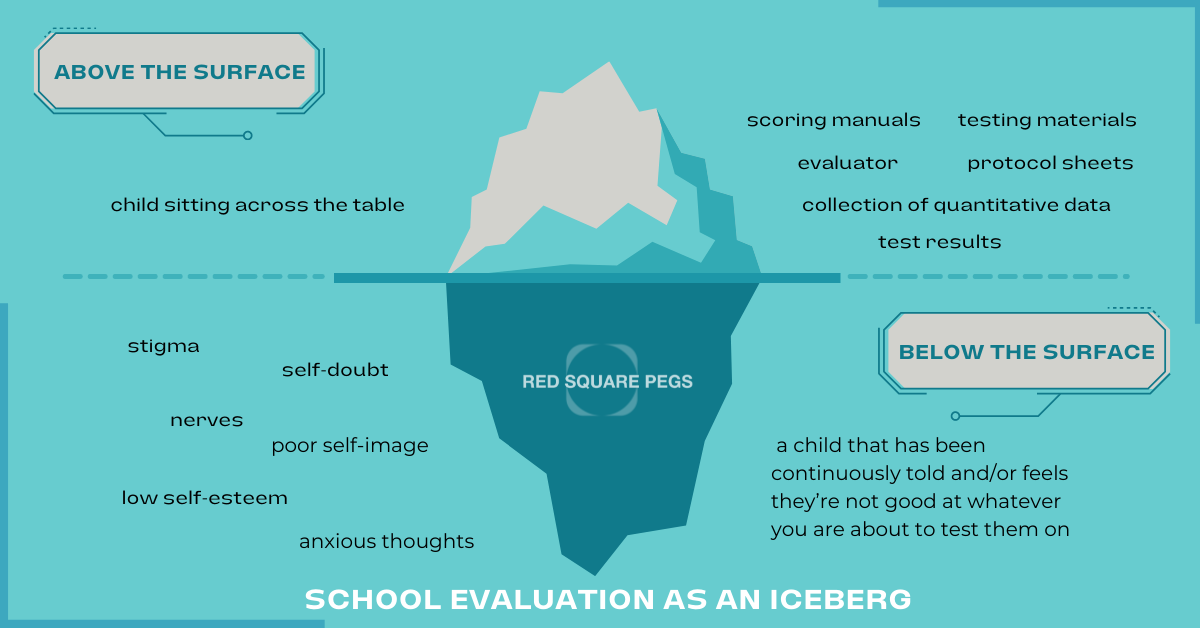How to Navigate the Evaluation Iceberg
From a Clinician's Point of View
POSTED ON: February 14, 2022

From an outsider’s perspective, the job of an evaluator may seem to just be collecting quantitative data and test results from the child they’re assessing. However, evaluators such as speech-language pathologists, psychologists, etc. are also tasked with building a trusting relationship with the individual they are evaluating. The base of that trusting relationship is the rapport built with the individual, which may come more naturally to some evaluators while others may need to develop those skills.
Think of the evaluation as an iceberg. On the surface, you only see the child sitting across the table from you–testing materials, protocol sheets, and scoring manuals. If you look below the surface, you can potentially find anxious thoughts, poor self-image, stigma, self-doubt, nerves, low self-esteem, and a child that has been continuously told they’re not good at whatever you are about to test them on. Building rapport with the child and being transparent about the evaluation process will help them feel more comfortable and at ease.
The following are some tips and tricks to building rapport with a child prior to starting the evaluation:
- Finding Common Ground: This can be done by asking the child about their favorite food, what they like to do for fun, favorite TV show/movie, their family, and what pets they have. A child will feel more comfortable with you if they find they have something in common with you.
- Engaging in Their Interests: In case you can’t find common ground with this child, ask questions about their interests whether it be astronomy, dinosaurs, a tv series, animals, or a video game. They can feel more at ease if they feel like they are teaching you something and sharing what they are passionate about.
- Share About Yourself: There is immense value in the child realizing and understanding that you are human with a life too, not just an intimidating adult who is about to ask them a gazillion questions.
- Create a Warm and Welcoming Environment: This can be accomplished through your tone of voice, word choice, getting down to their level, presenting the test as a game, and offering breaks when needed.
When you are evaluating a child for dyslexia, you will likely encounter the aforementioned “iceberg” of icky feelings and self-doubt. Some strategies that have been successful for me in the past include:
- Asking the student why they are here today. This will give you an idea of what their caregiver has already told them or not told them. I’ve had students in the past who had no idea why they were in my office and others who knew they were being evaluated to see if they had dyslexia.
- Explain WHY you are doing the testing. Framing it in a positive way that makes it not seem like they are taking a test is empowering for a child. A phrase you could use is, “We are here to see how you/your brain learns best.” Assure the child that they will not be getting a grade for the test and that there is not a pass or fail label.
- This next tip can be trickier for younger students to wrap their brains around. Explain to the students that there is a frustration point for each activity you do and you have to keep going until they just can’t do it anymore or it becomes too hard. The frustration point can be very discouraging for students as they encounter that all too familiar feeling of not being good enough or they feel like they’re failing. This will prepare the child that they may feel frustrated during testing and it’s completely okay.
Children deserve explanations and respect during the evaluation process, which helps lay the framework for viewing special education through a positive lens. Building a trusting relationship with the child during an evaluation is just as important as gathering all of the data and scores during the testing. The evaluation may not be the last time you see that child, they could become a student on your caseload that you work with regularly. Creating that foundation of trust and rapport during testing can yield a more positive experience and relationship throughout treatment.
Red Square Pegs was established to empower dyslexics by embracing dyslexia through awareness and shared experiences and to be a symbol of acceptance, pride, and confidence.

